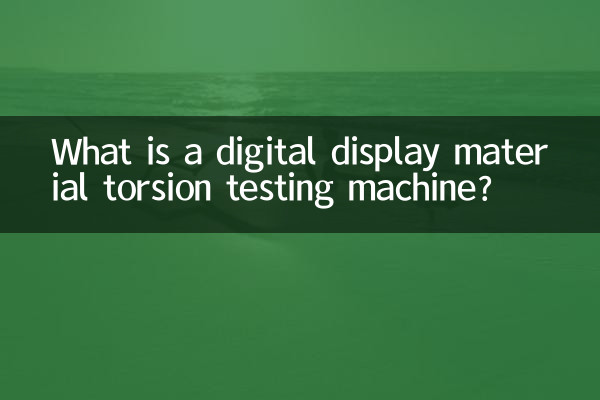What is a digital display material torsion testing machine?
In the fields of industrial manufacturing, materials research and quality control, the digital display material torsion testing machine is an important testing equipment. It is mainly used to measure the mechanical properties of materials under torsion force, such as torsional strength, torsional stiffness and fracture characteristics. With the advancement of science and technology, digital display technology has brought higher accuracy and convenience to testing machines, and has become an indispensable tool in modern laboratories and production lines.
The following are the hot topics and content about digital display material torsion testing machines on the Internet in the past 10 days:

| topic | heat index | Main discussion content |
|---|---|---|
| Technical advantages of digital torsion testing machine | 85 | High-precision sensors, real-time data display, automated testing process |
| Application fields of digital torsion testing machine | 78 | Testing of metal materials, composite materials, plastics, rubber and other materials |
| Digital torsion testing machine purchasing guide | 72 | Brand comparison, price range, functional requirement analysis |
| Maintenance and maintenance of digital torsion testing machine | 65 | Routine cleaning, sensor calibration, software upgrades |
| The future development trend of digital torsion testing machines | 60 | Intelligence, IoT integration, big data analysis |
Working principle of digital display material torsion testing machine
The digital material torsion testing machine applies torsional load through a motor or hydraulic system, while using high-precision sensors to measure torque and torsion angle. Test data is displayed in real time through a digital display and can be recorded and analyzed through computer software. The following is its main workflow:
1.Sample installation: Fix the material to be tested in the clamping device of the testing machine.
2.Parameter settings: Set test speed, twist angle and other parameters through the control panel or software.
3.test execution: Start the testing machine and apply torsional load until the material breaks or reaches the preset condition.
4.Data collection: The sensor collects torque and angle data in real time and displays it through the digital display system.
5.Result analysis: The software automatically generates test reports, including key indicators such as maximum torque and torsional stiffness.
Technical advantages of digital display material torsion testing machine
Compared with traditional mechanical torsion testing machines, digital display material torsion testing machines have the following significant advantages:
| Technical features | Advantage description |
|---|---|
| High precision sensor | The measurement accuracy can reach ±0.5%, which is much higher than the ±2% of mechanical instruments. |
| Real-time data display | During the test process, the torque-angle curve can be monitored in real time to facilitate timely adjustment. |
| Automated testing | Supports programming control, enabling batch testing and automatic data storage. |
| user friendly interface | Touch screen operation, multi-language support, lowering the threshold of use. |
Application scenarios of digital display material torsion testing machine
Digital display material torsion testing machine is widely used in the following fields:
1.Metal Materials Research: Test the torsional performance of steel, aluminum alloy and other metals to provide basis for product design.
2.Auto parts testing: Evaluate the torsion resistance of key components such as drive shafts and bolts.
3.Plastic and Rubber Testing: Study the deformation characteristics of polymer materials under the action of torsional force.
4.Teaching quality control: University laboratories are used for materials mechanics teaching and scientific research.
5.Aerospace: Ensuring the reliability of aircraft and spacecraft materials under extreme conditions.
Things to note when purchasing a digital display material torsion testing machine
When purchasing a digital material torsion testing machine, you need to consider the following key factors:
| purchasing factors | Detailed description |
|---|---|
| Test range | Select the appropriate range (such as 100Nm, 500Nm, etc.) according to the material strength. |
| Accuracy level | For industrial-grade applications, it is recommended to choose 0.5 level or higher accuracy. |
| control system | Give priority to software that supports Windows systems to facilitate data export. |
| After-sales service | Understand the manufacturer's technical support capabilities and spare parts supply. |
| Certification standards | Confirm that the equipment complies with international testing standards such as ISO and ASTM. |
Future development trends
With the advancement of Industry 4.0, digital display material torsion testing machines are developing in the following directions:
1.Intelligent: Integrate AI algorithms to achieve automatic fault diagnosis and test plan optimization.
2.IoT integration: Support remote monitoring and data cloud storage to facilitate multi-location collaboration.
3.big data analysis: Establish a material performance prediction model through historical data mining.
4.Green energy saving: Adopt low power consumption design to reduce equipment operation energy consumption.
As an important tool for modern material testing, the digital display material torsion testing machine’s technological progress will continue to promote the development of related industries. Whether it is a R&D institution or a manufacturing enterprise, choosing a suitable torsion testing machine will provide a strong guarantee for improving product quality.

check the details

check the details